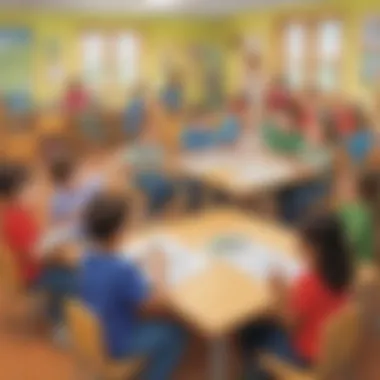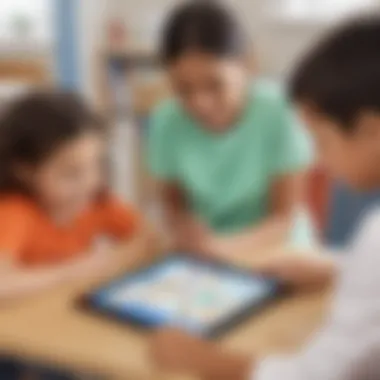Phonics Videos for Teachers: Boosting Literacy Instruction


Intro
In the digital age, the role of technology in education cannot be overstated. Phonics videos represent one of the innovative approaches to teaching literacy, especially in early childhood education. These resources can significantly enhance the instructional practices of teachers by providing visual and auditory stimuli that effectively engage young learners. This article will explore how phonics videos can be used as an integral component of literacy instruction, highlighting their pedagogical benefits, selecting criteria, and practical integration strategies.
Interactive Learning Games
Among the many tools available for engaging students, interactive learning games stand out. These games offer opportunities for youthful engagement and motivation, making learning an enjoyable experience.
Popular Games
Some of the most popular educational games include:
- Starfall: A platform offering interactive phonics games that cater to early readers.
- ABCmouse: An extensive program that includes phonics among various subjects, suitable for young learners.
- Endless Alphabet: Focused on vocabulary, this game employs entertaining animations to teach.
Description of Top Educational Games
Each of these games has unique features that make them effective. For instance, Starfall provides engaging animations and songs that reinforce phonics concepts. ABCmouse, on the other hand, offers a structured learning path that allows teachers to track progress. Lastly, Endless Alphabet emphasizes language acquisition, enhancing vocabulary while supporting phonics learning.
Benefits of Playing Educational Games for Kids' Cognitive Development
Engaging with educational games promotes cognitive skills. These benefits include:
- Improved problem-solving abilities.
- Enhanced critical thinking skills.
- Greater retention of information due to the interactive nature of games.
Learning through play nurtures children's natural curiosity while fostering a proactive learning attitude.
Game Reviews
In evaluating the effectiveness of educational games, reviews can provide key insights into user experience and learning outcomes.
- Starfall: Users often highlight its user-friendly interface and engaging content.
- ABCmouse: Reviews frequently praise its comprehensive curriculum, which supports teachers in delivering structured lessons.
- Endless Alphabet: Many applaud its entertaining format and interactive gameplay, which captivates young audiences.
Comparison of Gameplay and Learning Outcomes
When comparing these games, it is clear that design influences both engagement and learning outcomes. Both Starfall and ABCmouse emphasize structured learning, while Endless Alphabet leans toward creative exploration. Such diversity in approach caters to different learning styles among children, ultimately enhancing literacy skills across the board.
Educational Topics
A comprehensive literacy instruction plan encompasses various educational topics. The incorporation of interdisciplinary learning, involving subjects like math, science, and languages, can promote holistic development in children.
Importance of Interdisciplinary Learning for Holistic Development
Combining phonics with subjects such as science or social studies can help students see the practical applications of literacy skills. This broader perspective encourages critical thinking and fosters a more robust understanding of content.
Tips and Tricks
For both parents and educators, applying specific strategies can enhance children's learning journeys. Here are a few practical tips:
- Utilize phonics videos that align with current classroom content.
- Encourage collaborative activities among students to foster social skills while learning.
Strategies for Making Learning Fun and Engaging
Incorporating playful elements into lessons can dramatically increase student engagement. Activities could include phonics-themed scavenger hunts or group storytelling sessions that revolve around the sounds learned from phonics videos.
Creative DIY Projects
Hands-on activities add variety to the learning experience. Engaging in creative DIY projects can facilitate learning while also being enjoyable.
Step-by-Step Guides
Creating engaging DIY projects can be straightforward. For example, teachers can create a phonics word wall. Step-by-step, this involves:


- Choosing a theme for words (e.g., animals).
- Creating visuals for each word.
- Engaging students in decorating the wall together.
Craft Ideas
Organizing simple crafts, such as phonics flashcards using household items, encourages participation and artistic expression. The act of creating can also strengthen motor skills while reinforcing learning objectives.
Preamble to Phonics and Its Relevance
Phonics forms the bedrock of developing literacy skills in young learners. This method, which emphasizes the relationship between letters and sounds, is essential for mastering reading and writing. As educators look for effective resources to enhance their teaching, phonics videos have emerged as crucial tools. They serve not just as supplementary materials but as dynamic aids capable of making complex concepts more accessible. By integrating these videos into instruction, teachers can foster a deeper understanding of phonics, ultimately leading to improved literacy outcomes.
Defining Phonics
Phonics can be defined as a method of teaching reading and writing by correlating sounds with letters or groups of letters in an alphabetic writing system. The foundation of phonics is understanding the phoneme-grapheme relationship, which involves recognizing how letters represent sounds. Each letter or cluster of letters corresponds to a distinct sound in spoken language. This alignment enables students to decode words, thereby bridging the gap between oral and written language. By focusing on phonemic awareness, children learn to segment and blend sounds, which is vital for reading fluency and comprehension.
The Importance of Phonics in Early Literacy
The significance of phonics in early literacy cannot be overstated. It provides the fundamental skills children need to become proficient readers. Research indicates that phonics instruction boosts reading skills for young learners. When phonics is correctly taught, children show increased confidence and capability in reading. Early phonics education lays the groundwork for later literacy skills, including spelling and writing. Moreover, it enhances vocabulary development and comprehension abilities as students begin to understand the structure of language.
Additionally, phonics addresses the needs of diverse learners. Visual learners often benefit from phonics videos, which present information in a stimulating manner. Engaging audiovisual content helps maintain attention, making learning enjoyable and effective. Thus, phonics serves as more than just a teaching method; it is essential for nurturing a love for reading, critical thinking, and the overall development of literacy.
Role of Videos in Literacy Education
Videos have become a significant tool in literacy education. Their unique combination of visual and auditory elements makes them essential in teaching phonics. Phonics, which focuses on the relationship between sounds and their written symbols, lends itself well to video formats. Videos can demonstrate correct pronunciations and help clarify complex concepts through animations and visuals. In this article, the role of videos will be explored in detail, focusing on how they can enhance learning experiences.
Visual Learning and Its Implications
Visual learning is an effective strategy for many students, particularly young ones. Children often respond better to stimuli they can see. When they watch phonics videos, they are not only hearing sounds but also viewing the letters and words associated with those sounds. This multi-sensory approach reinforces learning. It enhances memory retention and makes abstract concepts more concrete. Research shows that integrating visual elements can significantly raise comprehension levels.
Moreover, visual learning accommodates various learning styles. Some students may struggle with traditional text-based methods. Videos enable them to absorb information without being impeded by reading challenges. Harnessing this method can lead to improved literacy skills in diverse classrooms.
Engagement Through Multimedia
Engagement is crucial for effective learning. Phonics videos can keep students' attention longer than conventional teaching methods. The integration of colorful graphics and lively animations captivates young viewers. This keeps them interested and motivated to learn. Videos can also incorporate music or sounds to illustrate different phonetic components, adding an additional layer of interaction.
Using multimedia can create a dynamic learning environment. Students often feel more comfortable discussing what they watched, allowing for richer classroom discussions. They can analyze and reflect on video content, which deepens their understanding of phonics concepts.
"Videos stimulate both sight and sound, making them one of the most engaging tools for learning phonics effectively."
Criteria for Effective Phonics Videos
In the quest to enhance literacy instruction through phonics videos, understanding the criteria for what makes a video effective is essential. A well-selected video can elevate the learning experience for young students. The key is to identify elements that align with educational standards and maintain high production quality. This section will discuss alignment with curriculum standards, clarity and quality of production, and the importance of age appropriateness and engagement levels in phonics videos.
Alignment with Curriculum Standards
Effective phonics videos should adhere to established curriculum standards. This alignment ensures that educators can integrate these resources into their teaching seamlessly. When videos support curriculum goals, teachers can use them as complementary tools to reinforce essential skills. It also helps to provide a structured approach to literacy instruction. Thus, before selecting any video, educators should check if it meets local educational guidelines. Skipping this step can lead to ineffective teaching methods or unproductive learning experiences.
Clarity and Quality of Production
The impact of video quality cannot be overlooked. High-quality production, both in visuals and sound, is crucial. Clarity in speech and images facilitates better understanding, especially for young learners. A poorly produced video can lead to confusion or disengagement. Aspects like voice clarity, background noise, and visual distractions play a major role in how students interact with content. A clear, professional presentation aids in maintaining student attention. Therefore, teachers should prioritize videos that showcase crisp visuals and clear audio to maximize engagement and learning outcomes.
Age Appropriateness and Engagement Level
Age appropriateness is another vital criterion. The content of phonics videos must match the developmental levels of the intended audience. Videos that cater to young learners need to be engaging, using colorful graphics and relatable characters. Keeping attention can be challenging for children. Therefore, videos should be designed to capture interest while delivering instructional content. Additionally, teachers should consider whether the pacing aligns with age expectations. A balance between educational content and entertainment can create a more enjoyable learning experience.
"Selecting phonics videos that meet these criteria can significantly enhance the effectiveness of literacy instruction."
Integrating Phonics Videos into Classroom Instruction
Integrating phonics videos into classroom instruction is essential for improving literacy among young learners. These videos serve as a valuable resource, merging visual and auditory learning methods. This section aims to explore ways teachers can effectively use phonics videos to enrich their teaching practices.
Creating a Blended Learning Environment
A blended learning environment combines traditional teaching methods with online resources. This model allows teachers to harness the strengths of both in-person and digital instruction. Phonics videos play a crucial role in this context.


- Flexibility: Teachers can assign videos for home viewing, allowing students to learn at their own pace.
- Tailored Learning: Videos can accommodate various learning styles, addressing the needs of diverse learners.
- Consistent Reinforcement: Students can revisit videos to reinforce concepts, making retention more likely.
By systematically integrating these tools, teachers foster an interactive educational landscape that promotes active engagement.
Incorporating Videos into Lesson Plans
Incorporating phonics videos into lesson plans can enhance engagement and understanding. Here are considered strategies to integrate videos effectively:
- Identify Learning Objectives: Before selecting a video, clearly define what skills or concepts need to be taught.
- Select Relevant Content: Choose videos that align with those objectives. Ensure videos are well-produced and age-appropriate.
- Embed Videos Thoughtfully: Integrate videos at strategic points in a lesson, such as introducing new phonics rules or supplementing hands-on activities.
These steps help create a cohesive learning experience and facilitate better understanding of phonics concepts.
Guided Practice with Video Resources
Guided practice is vital in phonics instruction. After watching a phonics video, teachers should lead students in activities that reinforce what they learned. This can look like:
- Interactive Exercises: Post-video activities like matching sounds with letters or making words can solidify concepts.
- Small Group Discussions: Facilitate collaborative discussions about the video content, ensuring all students participate. This peer interaction can deepen understanding.
- Ongoing Assessment: Utilize informal assessments to gauge comprehension after video engagement. This could include quick quizzes or thumbs-up/thumbs-down check-ins.
By involving students actively and providing support, teachers ensure that phonics videos are effective tools in literacy education.
Integrating phonics videos into the classroom shifts the focus from passive viewing to active engagement, fostering deeper learning outcomes.
Examples of High-Quality Phonics Videos
In the realm of literacy education, the significance of high-quality phonics videos cannot be overstated. These videos serve as essential tools for teachers, providing captivating content designed to engage young learners. They help bridge the gap between traditional literacy instruction and modern technological advancements. As educators consider integrating such resources, several critical factors come into play.
Popular Channels and Resources
When searching for phonics videos, educators should explore well-established channels known for their educational quality. Channels like Starfall and ABCmouse consistently provide engaging, curriculum-aligned content. PBS Kids also offers a variety of fun phonics videos that capture children's attention. Each of these platforms presents a diversity of content that appeals to different learning styles.
These resources often incorporate bright animations and relatable characters. This helps maintain student interest and initiative. Using these videos facilitates better retention of phonics concepts through repetition. Additionally, channels on YouTube, such as StoryBots and Super Simple Songs, have become popular for their entertaining yet educational videos. Teachers can enhance phonics instruction by utilizing these varied resources effectively.
Evaluating Video Content for Educational Value
Not all phonics videos are equal in terms of their educational value. Teachers must develop a keen eye for evaluating content quality to ensure they select effective resources. Here are some criteria to consider:
- Alignment with Learning Objectives: Videos should clearly convey phonics skills aligned with the curriculum standards. This ensures that what students learn through the videos reinforces classroom instruction.
- Production Quality: Assessing video clarity and audio quality is important. High production standards enhance comprehension. Look for videos with clear visuals and sound, avoiding distractions such as flickering images.
- Engagement Level: Content must be engaging. Videos should employ lively characters, rhythmic patterns, and interactive elements that sustain student attention. When children enjoy learning, they are more likely to absorb information.
- Educational Depth: Consider the depth of phonics skills covered. Videos should not only teach letter sounds but also include activities for blending and segmenting sounds, fostering a more comprehensive phonics understanding.
"The right resources can transform a classroom, capturing the imagination of students and enhancing their learning experiences."
By applying these evaluation criteria, teachers can identify superior phonics videos that contribute meaningfully to literacy instruction. Understanding these aspects enhances the effectiveness of phonics education, which is vital for early literacy success.
The Impact of Technology on Literacy Learning
Technology has transformed education, affecting how literacy is taught and learned. In this section, we explore the profound implications of technology for literacy teaching, especially through phonics videos. The integration of technology supports a dynamic learning environment. It allows educators to present phonics concepts in more engaging and interactive ways.
The use of videos provides visual support that can enhance comprehension. Students often benefit from seeing and hearing phonics in action. This multi-sensory approach caters to different learning styles, making literacy more accessible to a wider audience. The impact is notable, as technology not only supports traditional methods but also introduces new ways to captivate young learners.
One significant benefit of incorporating technology is the immediate access to diverse resources. There are countless phonics videos available that can be tailored to different age groups and learning levels. This availability ensures that teachers can select materials that align closely with their instructional goals.
Digital Literacy and Its Necessity
Digital literacy is an essential skill in the modern world. Students need to navigate a range of digital platforms competently. In the context of literacy instruction, digital literacy becomes a vital component. Through phonics videos, students gain exposure to various formats of information, from standard storytelling to interactive phonics games.
Incorporating digital literacy into literacy education has multiple advantages:
- It promotes critical thinking as students assess the credibility of sources.
- Students become adept at using technology, preparing them for future academic challenges.
- It encourages self-directed learning, empowering students to take charge of their educational journey.
Teaching literacy through technology, therefore, is not just about phonics. It is about preparing students for a future where digital skills are a prerequisite. The integration of digital literacy into phonics instruction can foster enthusiasm and engagement among young learners, cultivating a love for reading and learning.
Utilizing Interactive Tools alongside Videos


The inclusion of interactive tools enhances the effect of phonics videos in the classroom. Digital platforms can provide activities that reinforce the skills presented in videos. These interactive elements are essential because they allow students to engage directly with the material, solidifying their understanding of phonics concepts.
Some interactive tools that work well with phonics videos include:
- Online quizzes and games to test comprehension.
- Interactive whiteboards for group activities and discussions.
- Apps that provide personalized learning experiences based on student progress.
Educators can create a learning trajectory that is both responsive and effective. By combining interactive tools with videos, teachers create a rich educational experience. This not only aids retention of phonics knowledge but also fosters a collaborative learning environment where students can thrive.
Encouraging students to interact with phonics content actively leads to a deeper understanding and better mastery of literacy skills.
Assessing the Effectiveness of Phonics Videos
Assessing the effectiveness of phonics videos is crucial in ensuring that educators utilize these resources to their fullest potential. As teachers incorporate technology into their literacy instruction, it becomes necessary to evaluate whether these videos genuinely enhance learning outcomes. This assessment process can involve various strategies and methodologies which provide insights into their impact on student literacy development.
Key considerations in assessing the effectiveness of these videos include understanding the specific learning objectives, monitoring student engagement, and evaluating the skills acquired by learners over time. These elements emphasize the need for a systematic approach to measurement.
Methods for Measuring Student Progress
Quantifying student progress when using phonics videos demands a structured method. Here are a few effective techniques:
- Pre-and Post-Testing: Administering assessments before and after students engage with the videos can provide clear data on their learning gains. These tests should align with the skills being taught.
- Observational Assessments: Teachers can observe students during guided practice with the videos. This method allows educators to gauge engagement levels and reactions, ensuring that learners are actively absorbing the material.
- Tracking Attendance and Participation: Keeping records of how often students engage with the videos can help identify patterns in participation. A direct correlation may emerge between frequency of engagement and overall progress in skills acquisition.
- Engaging with Phonics Apps: Many educational apps provide analytics on student performance. Using these tools in conjunction with videos offers valuable quantitative data.
Gathering Feedback from Students and Educators
Collecting feedback is essential in understanding the impact of phonics videos from multiple perspectives. Both students and educators can offer insights that inform future instructional approaches.
- Student Surveys: Implementing anonymous surveys can encourage students to express their thoughts about the videos. Questions can address clarity, engagement, and perceived value in learning.
- Focus Groups: Bringing students together for discussions regarding their experiences with the videos can reveal deeper insights beyond what surveys might indicate.
- Teacher Reflections: Encouraging educators to keep reflective journals about their experiences using phonics videos can produce valuable narratives about the resources' effectiveness.
- Professional Development Workshops: Offering forums where educators discuss their findings can foster a culture of collaboration and shared learning, leading to enhancements in video resources used in classrooms.
"Regular assessment of phonics video effectiveness not only boosts literacy development but also enables tailored instruction based on individual student needs."
Incorporating these methods into the literacy curriculum ensures that phonics videos remain a relevant and impactful resource for both educators and learners. By continuously striving to assess and improve the tools used in classrooms, teachers can significantly contribute to the foundational literacy skills of their students.
Future Trends in Phonics Education
Exploring future trends in phonics education is pertinent for educators seeking to evolve their teaching methodologies. Adapting to emerging technologies and evolving pedagogical approaches can significantly enhance literacy instruction. Each trend presents unique benefits, allowing teachers to tailor their strategies effectively.
Emerging Technologies in Literacy Instruction
Emerging technologies are reshaping literacy instruction. Tools like artificial intelligence and interactive software create personalized learning experiences. For instance, applications such as Lexia Learning leverage adaptive technology to assess a child’s reading level and adjust content accordingly. This individualized approach helps address diverse learning paces and styles, optimizing student engagement and retention.
Moreover, virtual reality (VR) and augmented reality (AR) offer immersive learning experiences, bringing phonics concepts alive. Learners can visualize letters and sounds in real-time, promoting better understanding and recall.
Additionally, online platforms enable educators to access a vast array of phonics resources. Resources such as Teach Your Monster to Read provide engaging games that reinforce phonics instruction. Teachers can incorporate these tools into their lessons, enhancing that interactive element critical for young learners.
Potential Changes in Pedagogical Approaches
The shift in pedagogical approaches is crucial as well. Traditional methods of rote memorization are evolving towards more reflexive learning models. This movement places emphasis on understanding rather than memorization. Educators are increasingly encouraged to focus on phonemic awareness by using phonics videos that demonstrate sound-letter relationships through context.
Incorporating collaborative learning is an essential aspect. Group activities involving phonics videos foster discussion among students, ensuring that they articulate their understanding while learning from peers. Such collaborative learning environments can enhance critical thinking skills and allow for peer feedback.
Teachers are also examining the effectiveness of blended learning approaches. Combining physical classroom settings with online resources provides children with a multifaceted learning experience. This flexibility accommodates various needs and preferences, allowing educators to engage students better.
Closure
In the context of this article, the conclusion encapsulates the essential elements discussed throughout. It serves to reinforce the significance of phonics videos in literacy instruction and emphasizes their pivotal role in enhancing reading skills among young learners. Through this exploration, it becomes evident that phonics should not be viewed merely as a fundamental component of reading but as a vital instrument for educators to foster deep understanding and engagement in literacy education.
Summarizing Key Takeaways
The discussion has brought forth several key takeaways that are crucial for teachers considering the integration of phonics videos in their classrooms:
- Effective Resource Selection: Choosing phonics videos that align with curriculum standards ensures that the content is valuable and focused on educational goals.
- Engagement and Accessibility: Multimedia resources cater to various learning styles, helping maintain student interest and catering to diverse classroom settings.
- Measurement of Impact: Regular assessment of student progress and feedback from both learners and educators is vital in determining the effectiveness of phonics videos.
- Future Pedagogical Approaches: As technology evolves, so too should teaching strategies. Staying ahead of trends can augment the learning experience for all students.
Encouragement for Continued Exploration
It is imperative that educators continue to explore advancements in phonics education and the integration of multimedia tools. The landscape of literacy instruction is ever-changing, and embracing new resources offers the potential for improved educational outcomes. Teachers should not hesitate to experiment with diverse phonics videos and other interactive tools available.
Through continual exploration, educators will not only enrich their own teaching practices, but will also contribute positively to their students' literacy journeys. Engage with professional development opportunities and share successful strategies with peers to foster a collaborative approach to literacy education.
By prioritizing phonics in instructional strategies, educators can significantly impact their students' long-term reading abilities. The commitment to advancing literacy through innovative resources positions both teachers and students for success.















